# String Handling
A brief overview of Java’s string handling was presented in Chapter 7. In this chapter, it is described in detail. As is the case in most other programming languages, in Java a string is a sequence of characters. But, unlike some other languages that implement strings as character arrays, Java implements strings as objects of type String.
Implementing strings as built-in objects allows Java to provide a full complement of features that make string handling convenient. For example, Java has methods to compare two strings, search for a substring, concatenate two strings, and change the case of letters within a string. Also, String objects can be constructed a number of ways, making it easy to obtain a string when needed.
Somewhat unexpectedly, when you create a String object, you are creating a string that cannot be changed. That is, once a String object has been created, you cannot change the characters that comprise that string. At first, this may seem to be a serious restriction. However, such is not the case. You can still perform all types of string operations. The difference is that each time you need an altered version of an existing string, a new String object is created that contains the modifications. The original string is left unchanged. This approach is used because fixed, immutable strings can be implemented more efficiently than changeable ones. For those cases in which a modifiable string is desired, Java provides two options: StringBuffer and StringBuilder. Both hold strings that can be modified after they are created.
The String, StringBuffer, and StringBuilder classes are defined in java.lang. Thus, they are available to all programs automatically. All are declared final, which means that none of these classes may be subclassed. This allows certain optimizations that increase performance to take place on common string operations. All three implement the CharSequence interface.
One last point: To say that the strings within objects of type String are unchangeable means that the contents of the String instance cannot be changed after it has been created. However, a variable declared as a String reference can be changed to point at some other String object at any time.
# The String Constructors
The String class supports several constructors. To create an empty String, call the default constructor. For example,
String s = new String();
will create an instance of String with no characters in it.
Frequently, you will want to create strings that have initial values. The String class provides a variety of constructors to handle this. To create a String initialized by an array of characters, use the constructor shown here:
String(char[ ] chars)
Here is an example:

This constructor initializes s with the string "abc".
You can specify a subrange of a character array as an initializer using the following constructor:
String(char[ ] chars, int startIndex, int numChars)
Here, startIndex specifies the index at which the subrange begins, and numChars specifies the number of characters to use. Here is an example:

This initializes s with the characters cde.
You can construct a String object that contains the same character sequence as another String object using this constructor:
String(String strObj)
Here, strObj is a String object. Consider this example:

The output from this program is as follows:

As you can see, s1 and s2 contain the same string.
Even though Java’s char type uses 16 bits to represent the basic Unicode character set, the typical format for strings on the Internet uses arrays of 8-bit bytes constructed from the ASCII character set. Because 8-bit ASCII strings are common, the String class provides constructors that initialize a string when given a byte array. Two forms are shown here:

Here, chrs specifies the array of bytes. The second form allows you to specify a subrange. In each of these constructors, the byte-to-character conversion is done by using the default character encoding of the platform. The following program illustrates these constructors:

This program generates the following output:

Starting with JDK 18, the default platform encoding is UTF-8, where previous JDKs chose an encoding that was dependent on the locale and operating system. Since UTF-8 has now become so widely adopted, this is usually the one you will want. But if you want to specify the encoding yourself, extended versions of the byte-to-string constructors are also defined in which you can specify the character encoding that determines how bytes are converted to characters. However, you will often want to use the default encoding provided by the platform.
NOTE The contents of the array are copied whenever you create a String object from an array. If you modify the contents of the array after you have created the string, the String will be unchanged.
You can construct a String from a StringBuffer by using the constructor shown here:
String(StringBuffer strBufObj)
You can construct a String from a StringBuilder by using this constructor:
String(StringBuilder strBuildObj)
The following constructor supports the extended Unicode character set:
String(int[ ] codePoints, int startIndex, int numChars)
Here, codePoints is an array that contains Unicode code points. The resulting string is constructed from the range that begins at startIndex and runs for numChars.
There are also constructors that let you specify a Charset.
NOTE A discussion of Unicode code points and how they are handled by Java is found in Chapter 19.
# String Length
The length of a string is the number of characters that it contains. To obtain this value, call the length() method, shown here:
int length()
The following fragment prints "3", since there are three characters in the string s:

# Special String Operations
Because strings are a common and important part of programming, Java has added special support for several string operations within the syntax of the language. These operations include the automatic creation of new String instances from string literals, concatenation of multiple String objects by use of the + operator, and the conversion of other data types to a string representation. There are explicit methods available to perform all of these functions, but Java does them automatically as a convenience for the programmer and to add clarity.
# String Literals
The earlier examples showed how to explicitly create a String instance from an array of characters by using the new operator. However, there is an easier way to do this using a string literal. For each string literal in your program, Java automatically constructs a String object. Thus, you can use a string literal to initialize a String object. For example, the following code fragment creates two equivalent strings:

Because a String object is created for every string literal, you can use a string literal any place you can use a String object. For example, you can call methods directly on a quoted string as if it were an object reference, as the following statement shows. It calls the length() method on the string "abc". As expected, it prints "3".
System.out.println("abc".length());
# String Concatenation
In general, Java does not allow operators to be applied to String objects. The one exception to this rule is the + operator, which concatenates two strings, producing a String object as the result. This allows you to chain together a series of + operations. For example, the following fragment concatenates three strings:

This displays the string "He is 9 years old."
One practical use of string concatenation is found when you are creating very long strings. Instead of letting long strings wrap around within your source code, you can break them into smaller pieces, using the + to concatenate them. Here is an example:

# String Concatenation with Other Data Types
You can concatenate strings with other types of data. For example, consider this slightly different version of the earlier example:

In this case, age is an int rather than another String, but the output produced is the same as before. This is because the int value in age is automatically converted into its string representation within a String object. This string is then concatenated as before. The compiler will convert an operand to its string equivalent whenever the other operand of the + is an instance of String.
Be careful when you mix other types of operations with string concatenation expressions, however. You might get surprising results. Consider the following:

This fragment displays
four: 22
rather than the
four: 4
that you probably expected. Here’s why: Operator precedence causes the concatenation of "four" with the string equivalent of 2 to take place first. This result is then concatenated with the string equivalent of 2 a second time. To complete the integer addition first, you must use parentheses, like this:
String s = "four: " + (2 + 2);
Now s contains the string "four: 4".
# String Conversion and toString()
One way to convert data into its string representation is by calling one of the overloaded versions of the string conversion method valueOf() defined by String. valueOf() is overloaded for all the primitive types and for type Object. For the primitive types, valueOf() returns a string that contains the human-readable equivalent of the value with which it is called. For objects, valueOf() calls the toString() method on the object. We will look more closely at valueOf() later in this chapter. Here, let’s examine the toString() method, because it is the means by which you can determine the string representation for objects of classes that you create.
Every class implements toString() because it is defined by Object. However, the default implementation of toString() is seldom sufficient. For most important classes that you create, you will want to override toString() and provide your own string representations. Fortunately, this is easy to do. The toString() method has this general form:
String toString()
To implement toString(), simply return a String object that contains the human-readable string that appropriately describes an object of your class.
By overriding toString() for classes that you create, you allow them to be fully integrated into Java’s programming environment. For example, they can be used in print() and println() statements and in concatenation expressions. The following program demonstrates this by overriding toString() for the Box class:

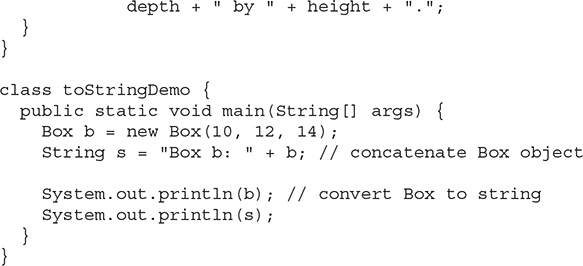
The output of this program is shown here:

As you can see, Box’s toString() method is automatically invoked when a Box object is used in a concatenation expression or in a call to println().
# Character Extraction
The String class provides a number of ways in which characters can be extracted from a String object. Several are examined here. Although the characters that comprise a string within a String object cannot be indexed as if they were a character array, many of the String methods employ an index (or offset) into the string for their operation. Like arrays, the string indexes begin at zero.
# charAt()
To extract a single character from a String, you can refer directly to an individual character via the charAt() method. It has this general form:
char charAt(int where)
Here, where is the index of the character that you want to obtain. The value of where must be nonnegative and specify a location within the string. charAt() returns the character at the specified location. For example,

assigns the value b to ch.
# getChars()
If you need to extract more than one character at a time, you can use the getChars() method. It has this general form:
void getChars(int sourceStart, int sourceEnd, char[ ] target, int targetStart)
Here, sourceStart specifies the index of the beginning of the substring, and sourceEnd specifies an index that is one past the end of the desired substring. Thus, the substring contains the characters from sourceStart through sourceEnd–1. The array that will receive the characters is specified by target. The index within target at which the substring will be copied is passed in targetStart. Care must be taken to ensure that the target array is large enough to hold the number of characters in the specified substring.
The following program demonstrates getChars():

Here is the output of this program:
demo
# getBytes()
There is an alternative to getChars() that stores the characters in an array of bytes. This method is called getBytes(), and it uses the default character-to-byte conversions provided by the platform. Here is its simplest form:
byte[ ] getBytes()
Other forms of getBytes() are also available. getBytes() is most useful when you are exporting a String value into an environment that does not support 16-bit Unicode characters.
# toCharArray()
If you want to convert all the characters in a String object into a character array, the easiest way is to call toCharArray(). It returns an array of characters for the entire string. It has this general form:
char[ ] toCharArray()
This function is provided as a convenience, since it is possible to use getChars() to achieve the same result.
# String Comparison
The String class includes a number of methods that compare strings or substrings within strings. Several are examined here.
# equals() and equalsIgnoreCase()
To compare two strings for equality, use equals(). It has this general form:
boolean equals(Object str)
Here, str is the String object being compared with the invoking String object. It returns true if the strings contain the same characters in the same order, and false otherwise. The comparison is case-sensitive.
To perform a comparison that ignores case differences, call equalsIgnoreCase(). When it compares two strings, it considers A-Z to be the same as a-z. It has this general form:
boolean equalsIgnoreCase(String str)
Here, str is the String object being compared with the invoking String object. It, too, returns true if the strings contain the same characters in the same order, and false otherwise.
Here is an example that demonstrates equals() and equalsIgnoreCase():

The output from the program is shown here:

# regionMatches()
The regionMatches() method compares a specific region inside a string with another specific region in another string. There is an overloaded form that allows you to ignore case in such comparisons. Here are the general forms for these two methods:


For both versions, startIndex specifies the index at which the region begins within the invoking String object. The String being compared is specified by str2. The index at which the comparison will start within str2 is specified by str2StartIndex. The length of the substring being compared is passed in numChars. In the second version, if ignoreCase is true, the case of the characters is ignored. Otherwise, case is significant.
# startsWith() and endsWith()
String defines two methods that are, more or less, specialized forms of regionMatches(). The startsWith() method determines whether a given String begins with a specified string. Conversely, endsWith() determines whether the String in question ends with a specified string. They have the following general forms:

Here, str is the String being tested. If the string matches, true is returned. Otherwise, false is returned. For example,
"Foobar".endsWith("bar")
and
"Foobar".startsWith("Foo")
are both true.
A second form of startsWith(), shown here, lets you specify a starting point:
boolean startsWith(String str, int startIndex)
Here, startIndex specifies the index into the invoking string at which point the search will begin. For example,
"Foobar".startsWith("bar", 3)
returns true.
# equals() Versus ==
It is important to understand that the equals() method and the == operator perform two different operations. As just explained, the equals() method compares the characters inside a String object. The == operator compares two object references to see whether they refer to the same instance. The following program shows how two different String objects can contain the same characters, but references to these objects will not compare as equal:


The variable s1 refers to the String instance created by "Hello". The object referred to by s2 is created with s1 as an initializer. Thus, the contents of the two String objects are identical, but they are distinct objects. This means that s1 and s2 do not refer to the same objects and are, therefore, not ==, as is shown here by the output of the preceding example:

# compareTo()
Often, it is not enough to simply know whether two strings are identical. For sorting applications, you need to know which is less than, equal to, or greater than the next. A string is less than another if it comes before the other in dictionary order. A string is greater than another if it comes after the other in dictionary order. The method compareTo() serves this purpose. It is specified by the Comparable<T> interface, which String implements. It has this general form:
int compareTo(String str)
Here, str is the String being compared with the invoking String. The result of the comparison is returned and is interpreted as shown here:

Here is a sample program that sorts an array of strings. The program uses compareTo() to determine sort ordering for a bubble sort:
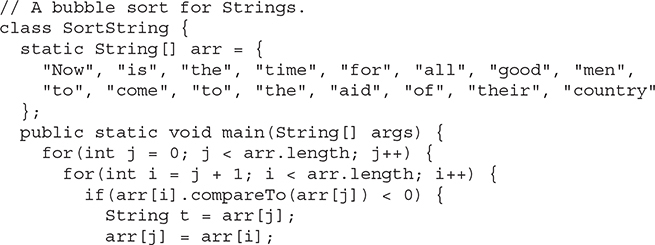

The output of this program is the list of words:

As you can see from the output of this example, compareTo() takes into account uppercase and lowercase letters. The word "Now" came out before all the others because it begins with an uppercase letter, which means it has a lower value in the ASCII character set.
If you want to ignore case differences when comparing two strings, use compareToIgnoreCase(), as shown here:
int compareToIgnoreCase(String str)
This method returns the same results as compareTo(), except that case differences are ignored. You might want to try substituting it into the previous program. After doing so, "Now" will no longer be first.
# Searching Strings
The String class provides two methods that allow you to search a string for a specified character or substring:
• indexOf() Searches for the first occurrence of a character or substring
• lastIndexOf() Searches for the last occurrence of a character or substring
These two methods are overloaded in several different ways. In all cases, the methods return the index at which the character or substring was found, or –1 on failure.
To search for the first occurrence of a character, use
int indexOf(int ch)
To search for the last occurrence of a character, use
int lastIndexOf(int ch)
Here, ch is the character being sought.
To search for the first or last occurrence of a substring, use

Here, str specifies the substring.
You can specify a starting point for the search using these forms:

Here, startIndex specifies the index at which point the search begins. For indexOf(), the search runs from startIndex to the end of the string. For lastIndexOf(), the search runs from startIndex to zero.
Beginning in JDK21, you can also specify an index range to narrow the search for the first occurrence of a character or substring using these forms:

Here, startIndex and endIndex specify the indices at which the search starts and ends, respectively. The first form searches for the substring given by str, the second for the character ch.
The following example shows how to use the various index methods to search inside of a String:
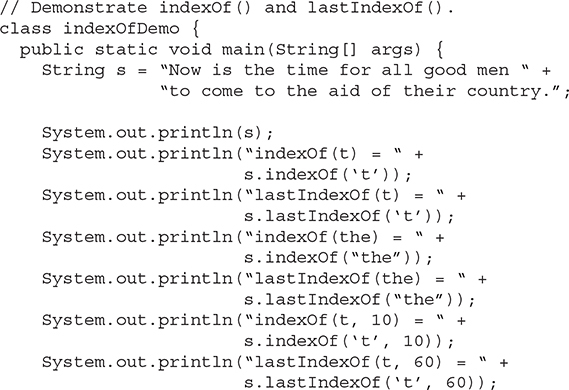

Here is the output of this program:

# Modifying a String
Because String objects are immutable, whenever you want to modify a String, you must either copy it into a StringBuffer or StringBuilder, or use a String method that constructs a new copy of the string with your modifications complete. A sampling of these methods are described here.
# substring()
You can extract a substring using substring(). It has two forms. The first is
String substring(int startIndex)
Here, startIndex specifies the index at which the substring will begin. This form returns a copy of the substring that begins at startIndex and runs to the end of the invoking string.
The second form of substring() allows you to specify both the beginning and ending index of the substring:
String substring(int startIndex, int endIndex)
Here, startIndex specifies the beginning index, and endIndex specifies the stopping point. The string returned contains all the characters from the beginning index, up to, but not including, the ending index.
The following program uses substring() to replace all instances of one substring with another within a string:

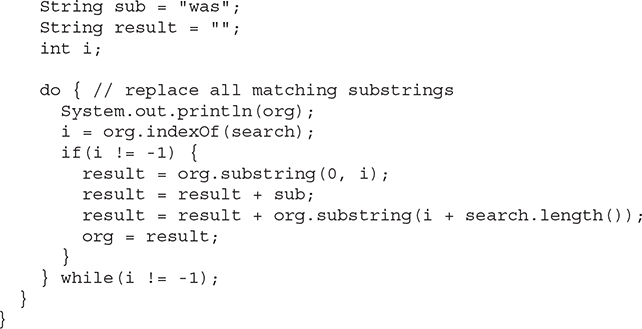
The output from this program is shown here:

# concat()
You can concatenate two strings using concat(), shown here:
String concat(String str)
This method creates a new object that contains the invoking string with the contents of str appended to the end. concat() performs the same function as +. For example,

puts the string "onetwo" into s2. It generates the same result as the following sequence:

# replace()
The replace() method has two forms. The first replaces all occurrences of one character in the invoking string with another character. It has the following general form:
String replace(char original, char replacement)
Here, original specifies the character to be replaced by the character specified by replacement. The resulting string is returned. For example,
String s = "Hello".replace('l', 'w');
puts the string "Hewwo" into s.
The second form of replace() replaces one character sequence with another. It has this general form:
String replace(CharSequence original, CharSequence replacement)
# trim() and strip()
The trim() method returns a copy of the invoking string from which any leading and trailing spaces have been removed. As it relates to this method, spaces consist of those characters with a value of 32 or less. The trim() method has this general form:
String trim()
Here is an example:
String s = " Hello World ".trim();
This puts the string "Hello World" into s.
The trim() method is quite useful when you process user commands. For example, the following program prompts the user for the name of a state and then displays that state’s capital. It uses trim() to remove any leading or trailing spaces that may have inadvertently been entered by the user.

Beginning with JDK 11, Java also provides the methods strip(), stripLeading(), and stripTrailing(). The strip() method removes all whitespace characters (as defined by Java) from the beginning and end of the invoking string and returns the result. Such whitespace characters include, among others, spaces, tabs, carriage returns, and line feeds.
The methods stripLeading() and stripTrailing() delete whitespace characters from the start and end, respectively, of the invoking string and return the result. JDK 15 added the methods stripIndent(), which removes extraneous whitespace while retaining meaningful indentation, and translateEscapes(), which replaces escape sequences with their character equivalents.
# Data Conversion Using valueOf()
The valueOf() method converts data from its internal format into a human-readable form. It is a static method that is overloaded within String for all of Java’s built-in types so that each type can be converted properly into a string. valueOf() is also overloaded for type Object, so an object of any class type you create can also be used as an argument. (Recall that Object is a superclass for all classes.) Here are a few of its forms:

As discussed earlier, valueOf() can be called when a string representation of some other type of data is needed. You can call this method directly with any data type and get a reasonable String representation. All of the simple types are converted to their common String representation. Any object that you pass to valueOf() will return the result of a call to the object’s toString() method. In fact, you could just call toString() directly and get the same result.
For most arrays, valueOf() returns a rather cryptic string, which indicates that it is an array of some type. For arrays of char, however, a String object is created that contains the characters in the char array. There is a special version of valueOf() that allows you to specify a subset of a char array. It has this general form:
static String valueOf(char[ ] chars, int startIndex, int numChars)
Here, chars is the array that holds the characters, startIndex is the index into the array of characters at which the desired substring begins, and numChars specifies the length of the substring.
# Changing the Case of Characters Within a String
The method toLowerCase() converts all the characters in a string from uppercase to lowercase. The toUpperCase() method converts all the characters in a string from lowercase to uppercase. Nonalphabetical characters, such as digits, are unaffected. Here are the simplest forms of these methods:

Both methods return a String object that contains the uppercase or lowercase equivalent of the invoking String. The default locale governs the conversion in both cases.
Here is an example that uses toLowerCase() and toUpperCase():

The output produced by the program is shown here:

One other point: Overloaded versions of toLowerCase() and toUpperCase() that let you specify a Locale object to govern the conversion are also supplied. Specifying the locale can be quite important in some cases and can help internationalize your application.
# Joining Strings
The join() method is used to concatenate two or more strings, separating each string with a delimiter, such as a space or a comma. It has two forms. Its first is shown here:
static String join(CharSequence delim, CharSequence . . . strs)
Here, delim specifies the delimiter used to separate the character sequences specified by strs. Because String implements the CharSequence interface, strs can be a list of strings. (See Chapter 19 for information on CharSequence.) The following program demonstrates this version of join():

The output is shown here:

In the first call to join(), a space is inserted between each string. In the second call, the delimiter is a comma followed by a space. This illustrates that the delimiter need not be just a single character.
The second form of join() lets you join a list of strings obtained from an object that implements the Iterable interface. Iterable is implemented by the Collections Framework classes described in Chapter 20, among others. See Chapter 19 for information on Iterable.
# Additional String Methods
In addition to those methods discussed earlier, String has many other methods. Several are summarized in the following table:

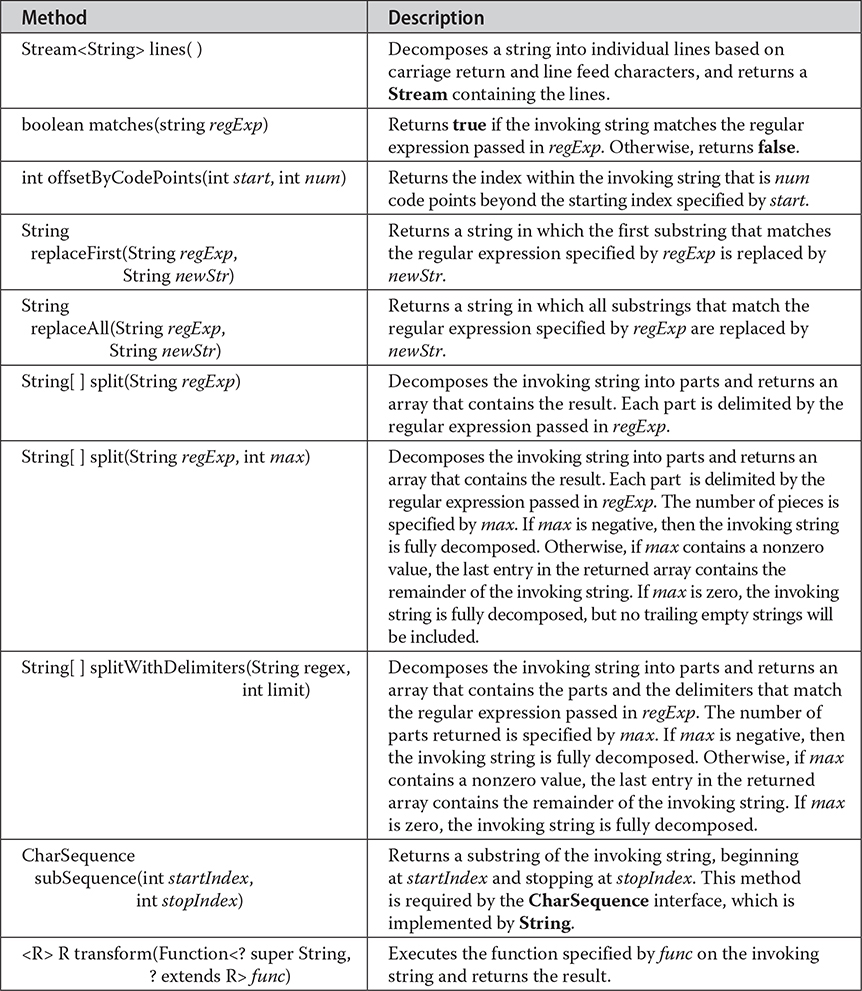
Notice that several of these methods work with regular expressions. Regular expressions are described in Chapter 31. One other point: Beginning with JDK 12, String implements the Constable and ConstantDesc interfaces.
# StringBuffer
StringBuffer supports a modifiable string. As you know, String represents fixed-length, immutable character sequences. In contrast, StringBuffer represents growable and writable character sequences. StringBuffer may have characters and substrings inserted in the middle or appended to the end. StringBuffer will automatically grow to make room for such additions and often has more characters preallocated than are actually needed, to allow room for growth.
# StringBuffer Constructors
StringBuffer defines these four constructors:

The default constructor (the one with no parameters) reserves room for 16 characters without reallocation. The second version accepts an integer argument that explicitly sets the size of the buffer. The third version accepts a String argument that sets the initial contents of the StringBuffer object and reserves room for 16 more characters without reallocation. StringBuffer allocates room for 16 additional characters when no specific buffer length is requested, because reallocation is a costly process in terms of time. Also, frequent reallocations can fragment memory. By allocating room for a few extra characters, StringBuffer reduces the number of reallocations that take place. The fourth constructor creates an object that contains the character sequence contained in chars and reserves room for 16 more characters.
# length() and capacity()
The current length of a StringBuffer can be found via the length() method, while the total allocated capacity can be found through the capacity() method. They have the following general forms:

Here is an example:

Here is the output of this program, which shows how StringBuffer reserves extra space for additional manipulations:

Since sb is initialized with the string "Hello" when it is created, its length is 5. Its capacity is 21 because room for 16 additional characters is automatically added.
# ensureCapacity()
If you want to preallocate room for a certain number of characters after a StringBuffer has been constructed, you can use ensureCapacity() to set the size of the buffer. This is useful if you know in advance that you will be appending a large number of small strings to a StringBuffer. ensureCapacity() has this general form:
void ensureCapacity(int minCapacity)
Here, minCapacity specifies the minimum size of the buffer. (A buffer larger than minCapacity may be allocated for reasons of efficiency.)
# setLength()
To set the length of the string within a StringBuffer object, use setLength(). Its general form is shown here:
void setLength(int len)
Here, len specifies the length of the string. This value must be nonnegative.
When you increase the size of the string, null characters are added to the end. If you call setLength() with a value less than the current value returned by length(), then the characters stored beyond the new length will be lost. The setCharAtDemo sample program in the following section uses setLength() to shorten a StringBuffer.
# charAt() and setCharAt()
The value of a single character can be obtained from a StringBuffer via the charAt() method. You can set the value of a character within a StringBuffer using setCharAt(). Their general forms are shown here:

For charAt(), where specifies the index of the character being obtained. For setCharAt(), where specifies the index of the character being set, and ch specifies the new value of that character. For both methods, where must be nonnegative and must not specify a location beyond the end of the string.
The following example demonstrates charAt() and setCharAt():


Here is the output generated by this program:
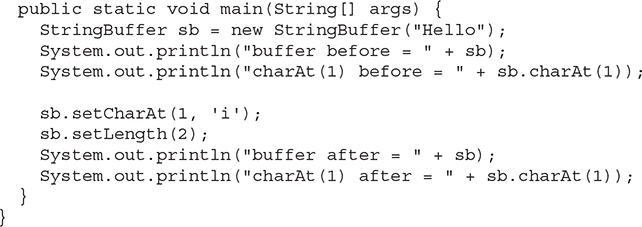
# getChars()
To copy a substring of a StringBuffer into an array, use the getChars() method. It has this general form:
void getChars(int sourceStart, int sourceEnd, char[ ] target, int targetStart)
Here, sourceStart specifies the index of the beginning of the substring, and sourceEnd specifies an index that is one past the end of the desired substring. This means that the substring contains the characters from sourceStart through sourceEnd–1. The array that will receive the characters is specified by target. The index within target at which the substring will be copied is passed in targetStart. Care must be taken to ensure that the target array is large enough to hold the number of characters in the specified substring.
# append()
The append() method concatenates the string representation of any other type of data to the end of the invoking StringBuffer object. It has several overloaded versions. Here are a few of its forms:

First, the string representation of each parameter is obtained. Then, the result is appended to the current StringBuffer object. The buffer itself is returned by each version of append(). This allows subsequent calls to be chained together, as shown in the following example:


The output of this example is shown here:
a = 42!
# insert()
The insert() method inserts one string into another. It is overloaded to accept values of all the primitive types, plus Strings, Objects, and CharSequences. Like append(), it obtains the string representation of the value it is called with. This string is then inserted into the invoking StringBuffer object. These are a few of its forms:

Here, index specifies the index at which point the string will be inserted into the invoking StringBuffer object.
The following sample program inserts "like" between "I" and "Java":

The output of this example is shown here:
I like Java!
# reverse()
You can reverse the characters within a StringBuffer object using reverse(), shown here:
StringBuffer reverse()
This method returns the reverse of the object on which it was called. The following program demonstrates reverse():


Here is the output produced by the program:

# delete() and deleteCharAt()
You can delete characters within a StringBuffer by using the methods delete() and deleteCharAt(). These methods are shown here:

The delete() method deletes a sequence of characters from the invoking object. Here, startIndex specifies the index of the first character to remove, and endIndex specifies an index one past the last character to remove. Thus, the substring deleted runs from startIndex to endIndex–1. The resulting StringBuffer object is returned.
The deleteCharAt() method deletes the character at the index specified by loc. It returns the resulting StringBuffer object.
Here is a program that demonstrates the delete() and deleteCharAt() methods:

The following output is produced:

# replace()
You can replace one set of characters with another set inside a StringBuffer object by calling replace(). Its signature is shown here:
StringBuffer replace(int startIndex, int endIndex, String str)
The substring being replaced is specified by the indexes startIndex and endIndex. Thus, the substring at startIndex through endIndex–1 is replaced. The replacement string is passed in str. The resulting StringBuffer object is returned.
The following program demonstrates replace():

Here is the output:
After replace: This was a test.
# substring()
You can obtain a portion of a StringBuffer by calling substring(). It has the following two forms:

The first form returns the substring that starts at startIndex and runs to the end of the invoking StringBuffer object. The second form returns the substring that starts at startIndex and runs through endIndex–1. These methods work just like those defined for String that were described earlier.
# Additional StringBuffer Methods
In addition to those methods just described, StringBuffer supplies others. Several are summarized in the following table:

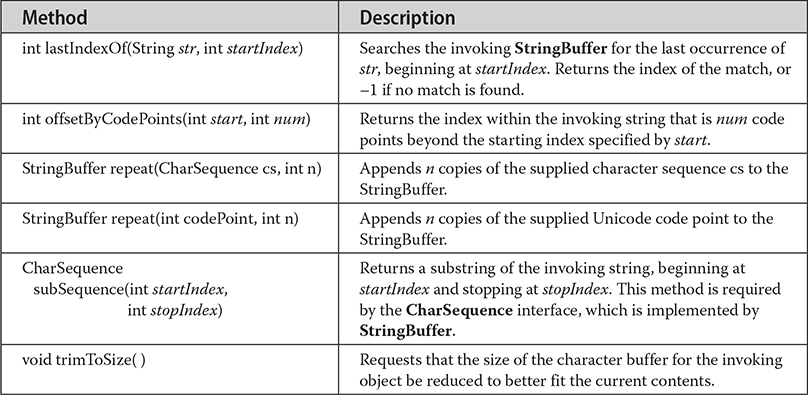
The following program demonstrates indexOf() and lastIndexOf():

The output is shown here:

# StringBuilder
StringBuilder is similar to StringBuffer, except for one important difference: it is not synchronized, which means that it is not thread-safe. The advantage of StringBuilder is faster performance. However, in cases in which a mutable string will be accessed by multiple threads, and no external synchronization is employed, you must use StringBuffer rather than StringBuilder.